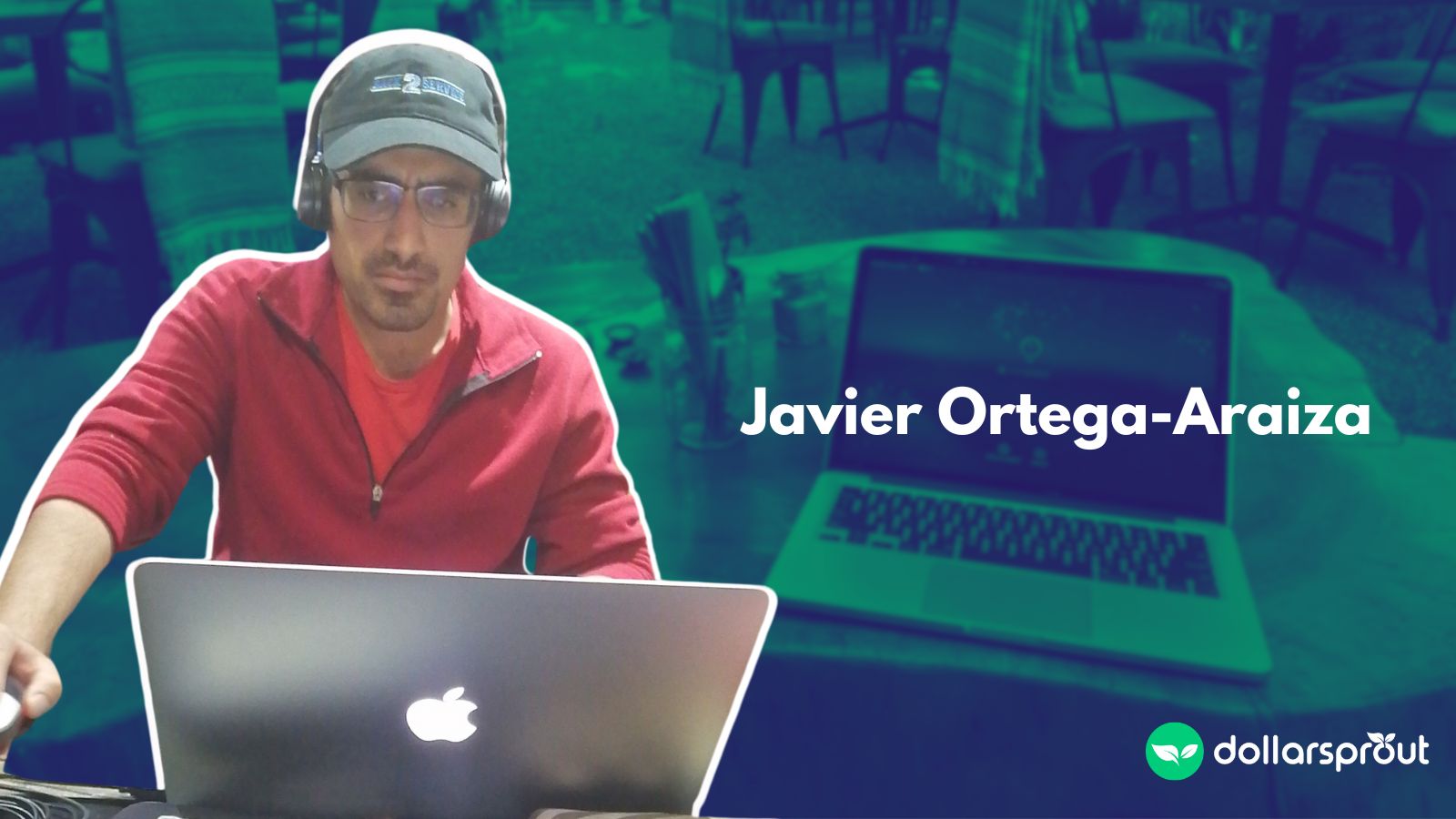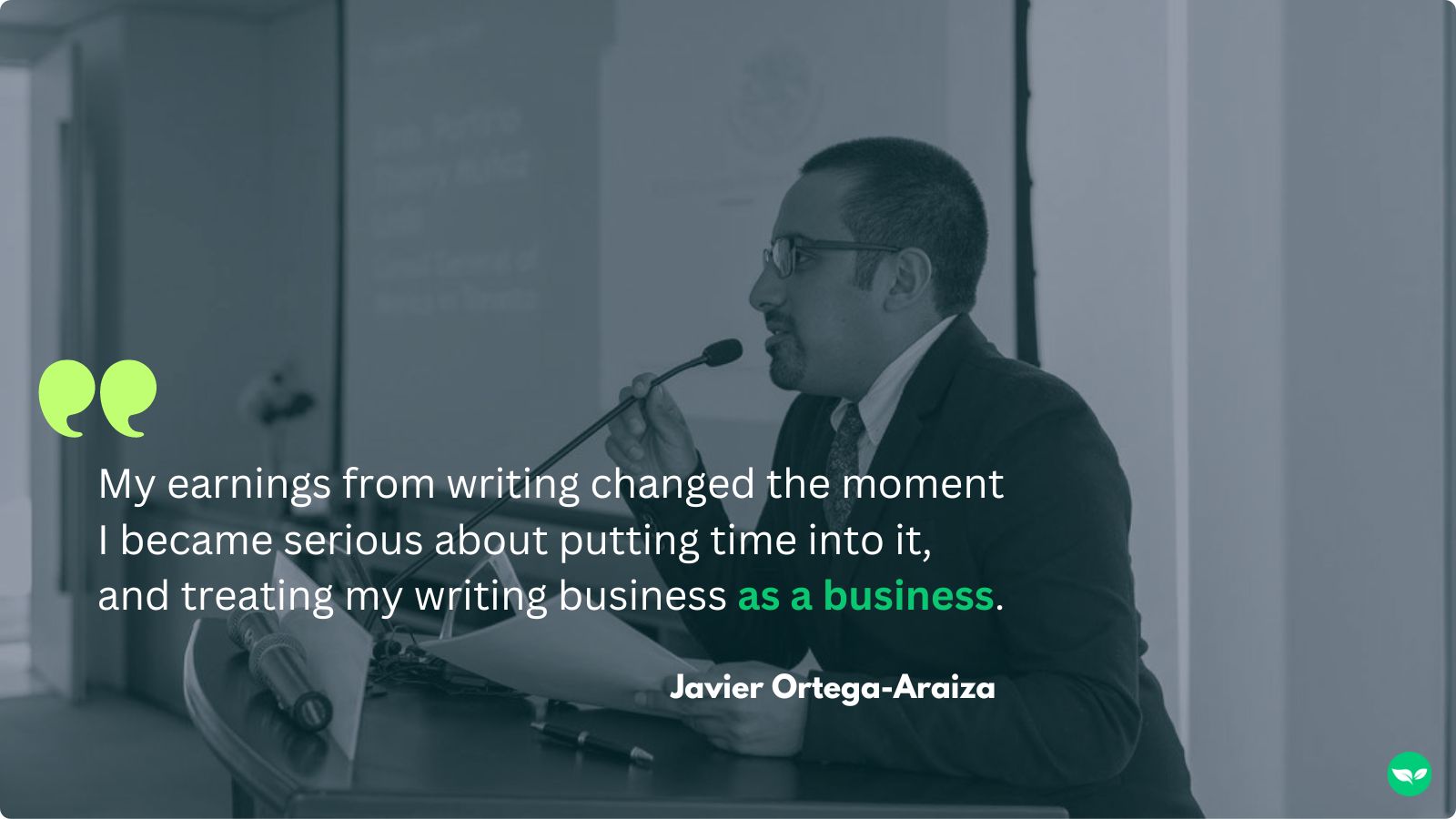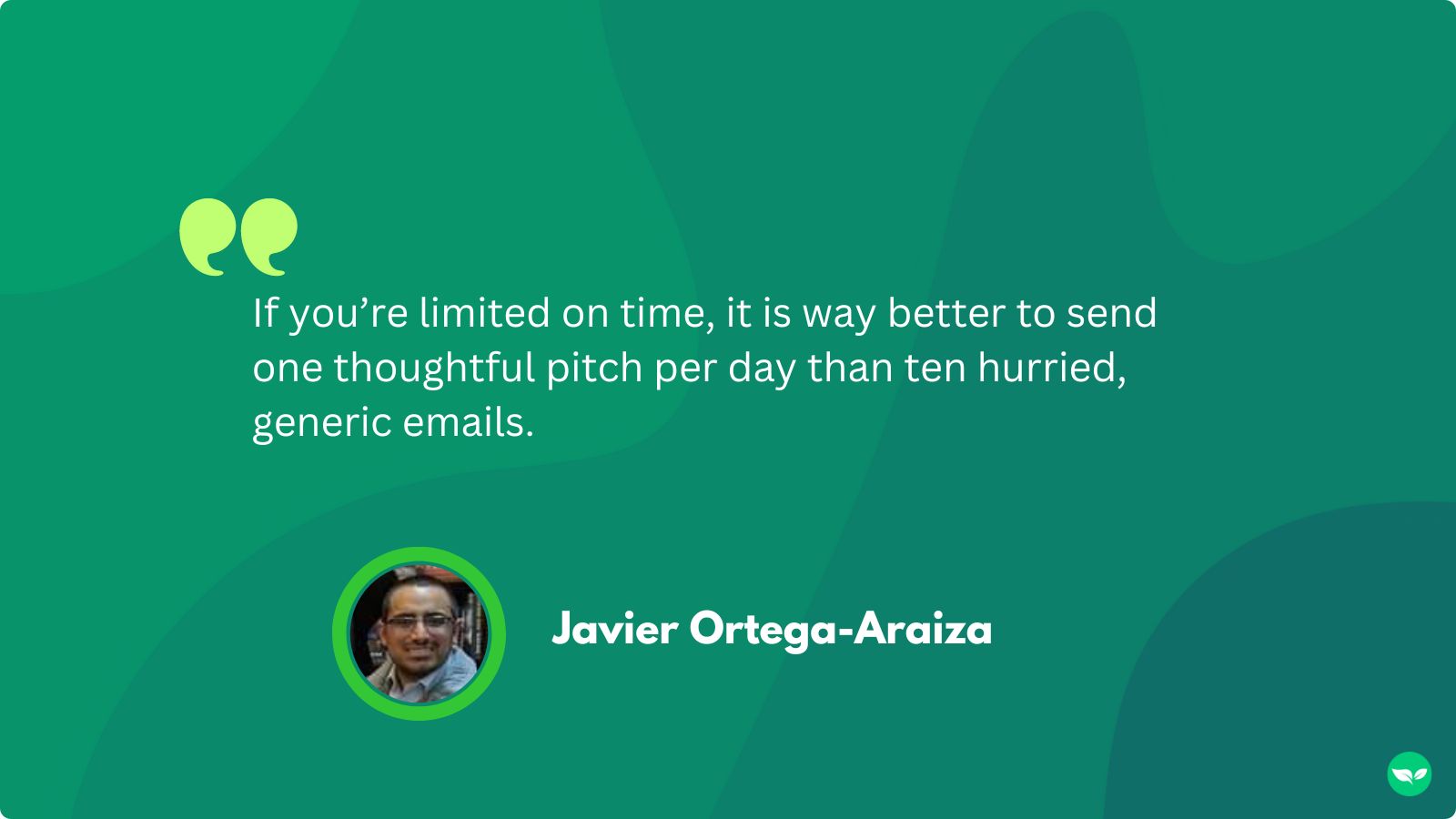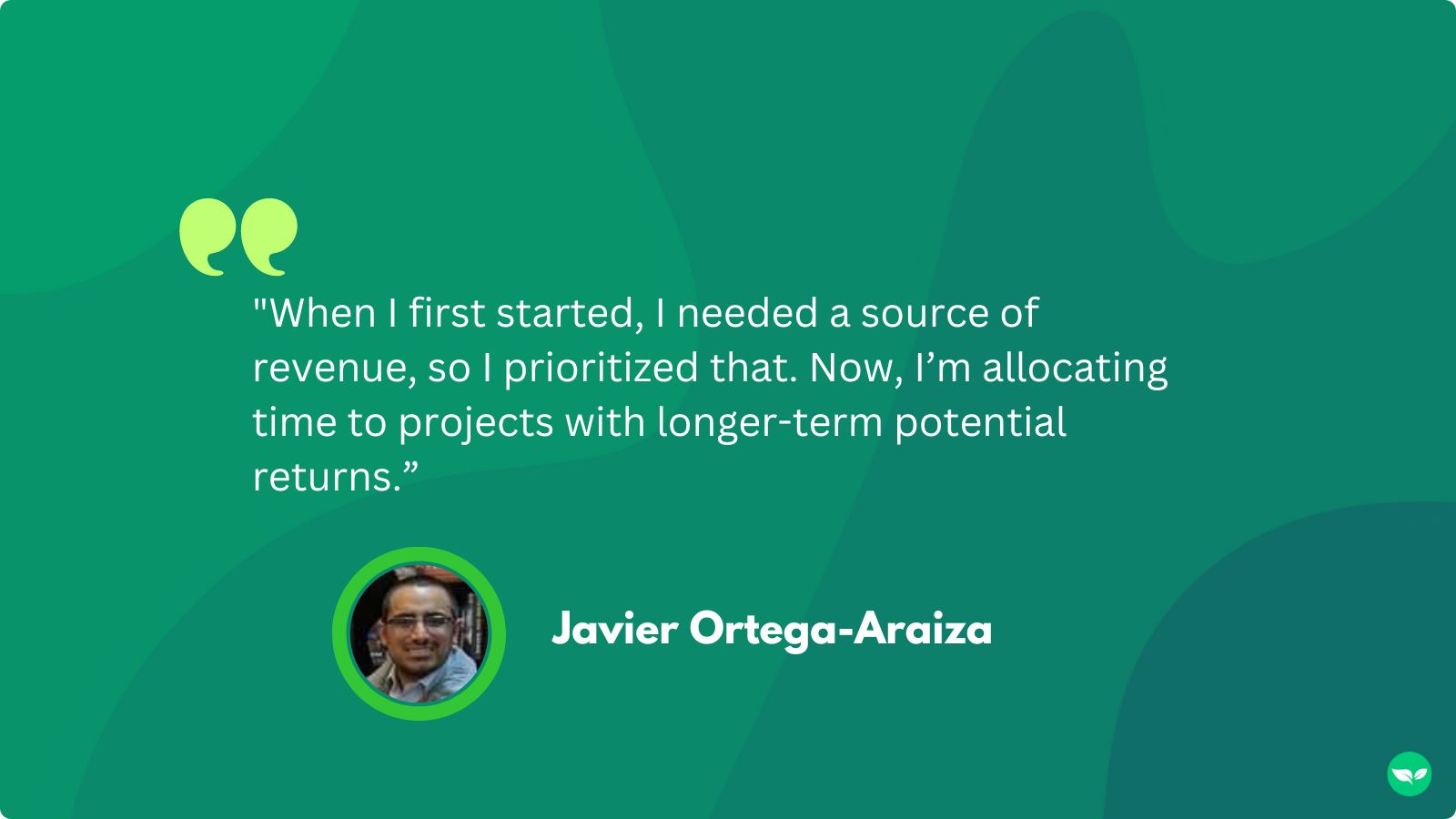Meet the Journalism Dropout Making Six Figures as a Freelance Writer
Javier Ortega-Araiza transformed his passion for storytelling into a six-figure freelance writing career. See his top tips and strategies for aspiring writers to turn their side hustle into a thriving profession.

“I feel the world is driven by stories and there’s so much power in what we have to share. Through stories we can help other people, we can inspire, we can inform, we can teach.”
That was Javier Ortega-Araiza’s response when asked what inspired him to become a freelance writer. And, despite being a journalism school dropout and dabbling in other careers, his true passion has always been writing and storytelling.
His story is proof that it isn’t always about what school you go to or what degree you have; if you have a passion for something, you can make a career out of almost anything.
The Prelude: His First Foray into Entrepreneurship
In business school, Javier started his first business which was centered around organizing immersive experiences for students who wanted to learn more about specific careers.
“I realized that if students could have a first-hand immersion into whatever they were into, maybe we could make more informed decisions about what path we wanted to pursue,” he explained. His business was a hit; Javier had surpassed $1.5 million in revenue within 18 months.
However, his success came with challenges. “I was very young and made wrong decisions, especially concerning people,” Javier admitted. These poor decisions eventually led to the business’s downfall.
“Losing that business jump-started my spiritual journey. After being close to opting out of life, I re-emerged stronger, with many stories to tell,” he reflected
Rediscovering Writing

While an undergraduate, Javier built a six-figure business writing papers for other students. However, he procrastinated on committing to writing as a career due to his own preconceived notions about its financial viability. He never viewed writing as a long-term career opportunity.
But when the pandemic hit, he decided to give freelance writing another shot.
“I wrote a few articles here and there for various outlets, but nothing consistent. My most consistent attempt had been writing on Medium, but I got disappointed because my earnings on the platform never surpassed $20.”
In 2022, Javier launched a few Substack newsletters and began pitching writing opportunities. “I started pitching every opportunity related to my topics of interest. The first few days, I received a lot of rejections, but gradually I got a couple of gigs, and I just gained traction from there,” he reflected.
Related: 12 Ways to Grow Your Income as a Freelance Writer
Five Pitches a Day, Every Day
Javier’s transition from treating freelance writing as a side hustle to making it his primary source of income was marked by a shift in mindset and discipline. “The gamechanger for me was this: My earnings from writing changed the moment I became serious about putting time into it, and treating my writing business as a business,” he explained.
In 2021 and 2022, Javier’s writing efforts were sporadic. “I published articles here and there, but they were scarce, and I did not have a habit of pitching publications consistently,” he admitted. This changed in 2023 when he set a clear and ambitious goal for himself. “I set a target of making at least five pitches a day, every workday. I reduced that gradually as I started to get more work, but I believe pitching so regularly also helped me hone my pitches and get better at identifying what editors were looking for.”
Javier also focused on building relationships with editors to secure ongoing work. “It was about building a relationship with some of those editors so that I could get ongoing work and not have to pitch so much,” he says. This strategy not only reduced the amount of pitching he needed to do but also helped him create a more stable and consistent income stream from his writing.
Reaching His First $10,000 Month
Javier’s persistence paid off. “I remember the first month my writing earnings surpassed $10,000. I was initially in disbelief. Did my words really earn me that?”
On average, he earns between $5,200 and $6,000 monthly from freelance writing, mostly because he has scaled back on some client work to focus on new projects. “I always have plenty of irons in the fire, so there’s no shortage of work,” he adds.
Javier’s Top 3 Challenges
Achieving success as a freelance writer did not come easy for Javier. Here are the top 3 challenges he says he faced as he was growing his business.
1. Balancing social needs with a solo profession
One of Javier’s biggest struggles during his first year of freelance writing was adjusting his schedule to meet his social and physical activity needs. “I need human interaction. I’m very social, and I’m an athlete,” he said, referencing his background as a competitive tennis player. Writing, however, can be isolating.
“I pivoted more times than I can count to make sure I had a schedule that worked for me,” Javier shared. Finding a balance that allowed him to be productive while maintaining his social interactions and physical activity was crucial. “When things are in balance, I love being in the zone and writing, but if I overdo it, I can get drained very quickly.”
2. Navigating the overwhelming “creator economy”
Another significant challenge was finding his way in the vast and overwhelming creator economy. “The creator economy is enormous; we constantly get bombarded by all kinds of ads, courses, coaches, and opportunities,” Javier explained.
In the beginning, he found it difficult to know where to start. “Everything can feel too much to digest.” To navigate this, he relied on newsletters that compiled opportunities from various platforms and centralized information, making it easier to manage. “I also relied on ChatGPT. It is an awesome assistant to structure complex scenarios and break them down into manageable tasks,” he added.
3. Balancing workload and income
Finding the right balance between making enough money and not overworking was another major challenge for Javier. “This required a lot of communication with my clients, especially those that paid per piece or per assignment,” he noted. He regularly communicated with editors to set expectations for each month, combining this information with the workload from clients who paid him a flat retainer. “Without having that line of communication open, it would have been a lot harder to plan for a month, and something would have suffered — my income, my health, or the quality of the work,” Javier said.
He emphasizes the importance of open and transparent communication with clients to achieve a balanced workload and maintain quality. “Even if, as freelancers, we’re independent contractors and we run our own business, we still need to learn how to work in teams and collaborate with our clients to reach our goals.”
A One-of-a-Kind Approach to Freelance Writing
Javier’s freelance writing strategy sets him apart due to his wide-ranging interests and refusal to confine himself to a single niche.
“So many people say that writers should find a ‘niche’ and stay within that niche,” Javier explains. While he acknowledges that focusing on a niche can be beneficial for specific publications, he believes that a writer’s body of work and personal brand can encompass much more.
Rather than limiting himself to one area, Javier embraces his many interests wholeheartedly. “I’ve written travel stories for literary magazines, done journalism for Canadian outlets, and even covered immigration issues,” he says. His passion for different subjects has opened numerous doors. For instance, his interest in entrepreneurship led him to write over 30 stories featuring inspiring individuals for Canadian newspapers like the Winnipeg Free Press and SaltWire-owned publications.
“I’ve published poetry books, written SEO articles on sports betting, explored personal development through tennis, and delved into mental health and spirituality,” he shares. His diverse interests have led him to write for prestigious outlets like Forbes, FOX, and the New York Post on topics ranging from personal finance to tech startups and venture capital.
This diverse approach has strengthened his writing. “Embracing various aspects of myself has made me a way better writer and given me better visibility of the big picture,” Javier notes. He believes that each line of work enhances the other, allowing him to bring a unique perspective to each project.
How Javier Finds Freelance Writing Clients
Knowing how to write well and knowing how to find freelance writing gigs are two very different skills, but you need both if you want to make it in this industry. Here’s how Javier goes about finding prospective clients.
1. Freelance gig newsletters
Javier finds newsletters to be invaluable in his client acquisition process. “Some newsletters really helped because they aggregate many opportunities and share them with people like me who don’t have the patience or time to scour LinkedIn, X, personal websites, and other portals like Indeed,” he explains. These newsletters provide a centralized source of potential gigs, saving him time and effort.
Related: 50 Freelance Jobs to Find Your Next Remote Gig
2. Old-fashioned research
Javier also employs a more traditional approach to finding clients. “I Google outlets that are looking for submissions on a particular topic I’m interested in, or brands that I believe can benefit from my input,” he shares. Once he identifies a potential client, he looks for a specific point of contact, avoiding generic email addresses. “Personalization is everything,” he insists. His detailed pitches highlight how he can add value to the client, increasing his chances of securing work.
3. Leveraging tools to find contact information
To streamline the process of finding contact information, Javier recommends using tools like RocketReach. “You can simply paste a LinkedIn profile, and it will give you an email address for whoever you’re trying to get in touch with,” he explains. He says it’s very effective, with an accuracy rate of over 90%.
It’s All About the Pitch: Javier’s Top Tips for Landing Clients
Javier emphasizes the importance of crafting effective pitches. Here are his top tips:
- Personalize Your Pitch: “If you’re limited on time, it is way better to send one thoughtful pitch per day than ten hurried, generic emails.” Taking the time to tailor each pitch shows potential clients that you value their specific needs and interests, making you stand out from generic submissions.
- Research Your Audience: “Do a Google query on a person and learn more about them. Genuine compliments and specific reasons why you can contribute to their mission can set you apart.” Understanding who you’re pitching to and showing genuine interest in their work can make a significant difference in your pitch’s reception.
- Share Relevant Work: “I tell them what I like about their work, how I believe my work can bolster it, and why I am the right person for the job. Relevant pieces from my portfolio, like my Substack on sports betting, have helped me secure gigs.” Highlighting work that aligns with the client’s interests demonstrates your expertise and relevancy to their needs.
- Be Honest: “For one personal finance section, I admitted I had no experience writing about credit cards but explained how I’d figure it out. Honesty helped me get started.” Transparency about your experience builds trust and shows potential clients your willingness to learn and adapt.
- Avoid Working for Free: “I don’t consider outlets that ask for finished pieces or unpaid samples. If someone doesn’t value my time in the short run, how can I trust they will in the long haul?” Valuing your work and time ensures that you establish relationships with clients who respect and appreciate your contributions from the outset.
Related: Should You Work for Free? 5 Scenarios You’ll Be Tempted To
On utilizing the “Deep Work” approach to time management
Javier employs Cal Newport’s “Deep Work” strategy to manage his time and projects effectively. He blocks specific periods for different types of work to maintain focus and ensure quality. “Editing with the PR agency requires me to be more responsive, so I allocate some time for that to be able to respond in real-time,” he explains. This method allows him to handle diverse tasks without mixing different types of writing.
By dedicating time blocks to specific tasks, Javier ensures that each project receives the attention it deserves. “The key is to not get different types of writing mixed up,” he advises. This separation helps him maintain clarity and productivity throughout his workday.
Another simple yet effective tip that Javier swears by is reading similar articles before starting a new piece. “Before writing a piece, read some articles that are similar or about the topic you need to write about,” he suggests. This practice helps stimulate creativity and ensures he is in the right mindset for the task at hand.
Javier’s Advice for Aspiring Freelance Writers
Drawing on his own experiences, Javier shares practical advice for stay-at-home parents, working professionals, and students who are considering freelance writing as a side hustle.
Embrace your unique story or perspective
Javier believes that everyone has a story worth telling. “A lot of people who I’ve spoken with doubt the power of their own story. They say, ‘What am I going to write about?’ But we’ve all lived through stuff. We all have interests,” he says. He emphasizes that the creator economy has room for everyone, with diverse topics and thriving communities around nearly any subject.
Set realistic expectations
For stay-at-home parents, working professionals, and students, time management is crucial. “If you only have half an hour a day to build your freelance writing career, it is better to be honest and define how you can use that half an hour to move forward than to set unrealistic goals,” Javier says.
Balance the short term with the long term
Javier recommends adopting a portfolio approach to manage your freelance writing finances, similar to how someone might invest their savings. “When I first started, I needed a source of revenue, so I prioritized that. Now, I’m allocating time to projects with longer-term potential returns,” he explains. Finding that balance is key for stability and long term success.
And, speaking of investing, don’t forget to set aside money regularly towards retirement. Since you won’t have a normal employer that offers a 401(k) plan, it’s up to you to save on your own.
Break down goals into bite sized chunks
Starting a freelance writing career can feel overwhelming. Javier suggests breaking down larger goals into smaller, manageable steps. “This is something that inspired me to start Write Your Freedom.” That’s his business that helps new freelance writers get started without getting overwhelmed. He offers one-on-one coaching as well as group coaching.
Diversify your income
Javier stresses the importance of diversifying income sources within the creative economy. “I’ve had jobs end because media outlets ran out of money, and clients tried to reduce rates. That’s why I’m skeptical about the subscription model,” he says. Instead, he looks for innovative ways to leverage his writing. For instance, he plans to incorporate experiential trips related to his personal finance newsletter, offering unique value beyond regular content. Additionally, freelancers can diversify by offering coaching, public speaking, organizing retreats, or selling merchandise.
Related: How Holly Johnson Built a $200K/Yr Freelance Writing Career









